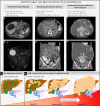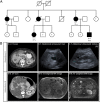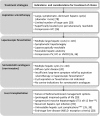Polycystic liver disease: an overview of pathogenesis, clinical manifestations and management
- PMID: 24886261
- PMCID: PMC4030533
- DOI: 10.1186/1750-1172-9-69
Polycystic liver disease: an overview of pathogenesis, clinical manifestations and management
Abstract
Polycystic liver disease (PLD) is the result of embryonic ductal plate malformation of the intrahepatic biliary tree. The phenotype consists of numerous cysts spread throughout the liver parenchyma. Cystic bile duct malformations originating from the peripheral biliary tree are called Von Meyenburg complexes (VMC). In these patients embryonic remnants develop into small hepatic cysts and usually remain silent during life. Symptomatic PLD occurs mainly in the context of isolated polycystic liver disease (PCLD) and autosomal dominant polycystic kidney disease (ADPKD). In advanced stages, PCLD and ADPKD patients have massively enlarged livers which cause a spectrum of clinical features and complications. Major complaints include abdominal pain, abdominal distension and atypical symptoms because of voluminous cysts resulting in compression of adjacent tissue or failure of the affected organ. Renal failure due to polycystic kidneys and non-renal extra-hepatic features are common in ADPKD in contrast to VMC and PCLD. In general, liver function remains prolonged preserved in PLD. Ultrasonography is the first instrument to assess liver phenotype. Indeed, PCLD and ADPKD diagnostic criteria rely on detection of hepatorenal cystogenesis, and secondly a positive family history compatible with an autosomal dominant inheritance pattern. Ambiguous imaging or screening may be assisted by genetic counseling and molecular diagnostics. Screening mutations of the genes causing PCLD (PRKCSH and SEC63) or ADPKD (PKD1 and PKD2) confirm the clinical diagnosis. Genetic studies showed that accumulation of somatic hits in cyst epithelium determine the rate-limiting step for cyst formation. Management of adult PLD is based on liver phenotype, severity of clinical features and quality of life. Conservative treatment is recommended for the majority of PLD patients. The primary aim is to halt cyst growth to allow abdominal decompression and ameliorate symptoms. Invasive procedures are required in a selective patient group with advanced PCLD, ADPKD or liver failure. Pharmacological therapy by somatostatin analogues lead to beneficial outcome of PLD in terms of symptom relief and liver volume reduction.
Figures




References
-
- Roskams T, Desmet V. Embryology of extra- and intrahepatic bile ducts, the ductal plate. Anat Rec (Hoboken) 2008;291:628–635. - PubMed
-
- Raynaud P, Carpentier R, Antoniou A, Lemaigre FP. Biliary differentiation and bile duct morphogenesis in development and disease. Int J Biochem Cell Biol. 2011;43:245–256. - PubMed
-
- Drenth JP, Chrispijn M, Bergmann C. Congenital fibrocystic liver diseases. Best Pract Res Clin Gastroenterol. 2010;24:573–584. - PubMed
Publication types
MeSH terms
Supplementary concepts
LinkOut - more resources
Full Text Sources
Other Literature Sources
Medical
Miscellaneous

